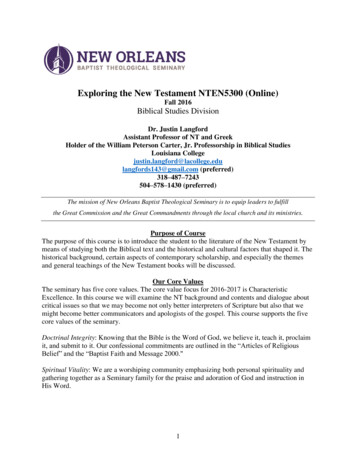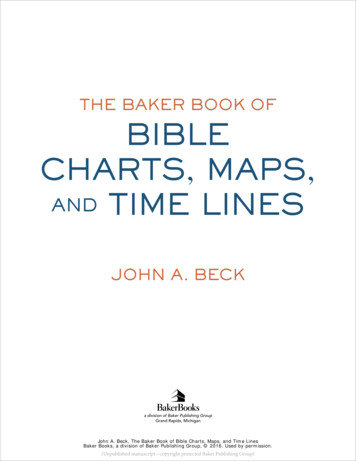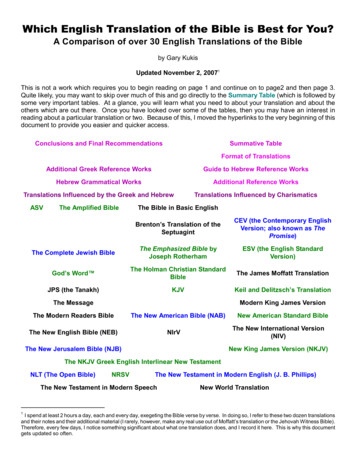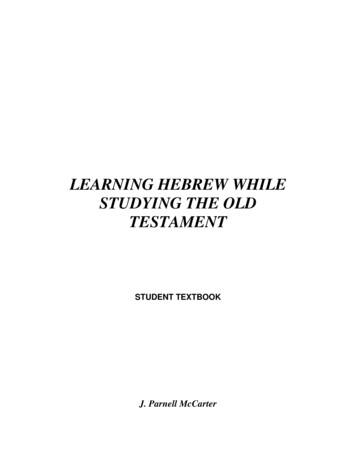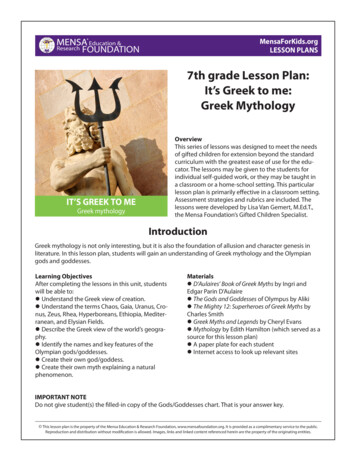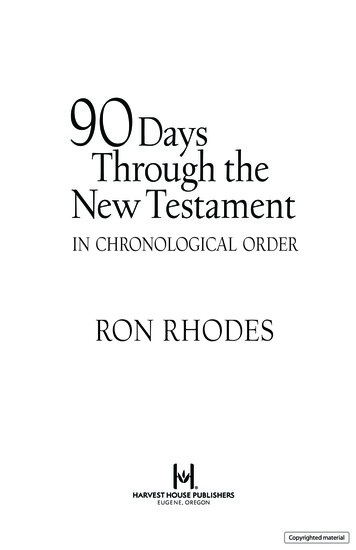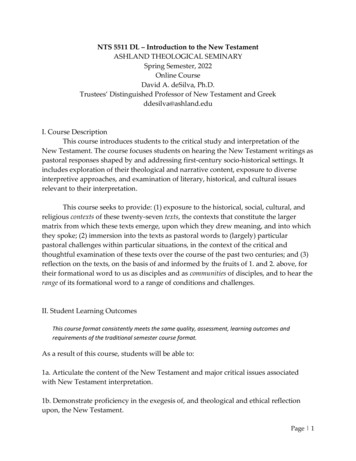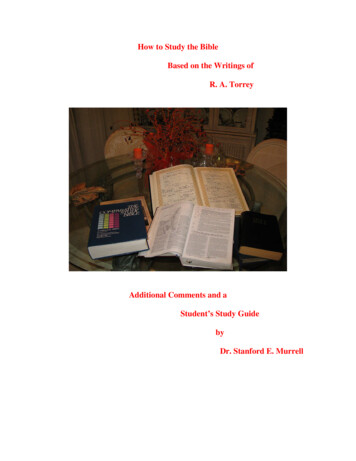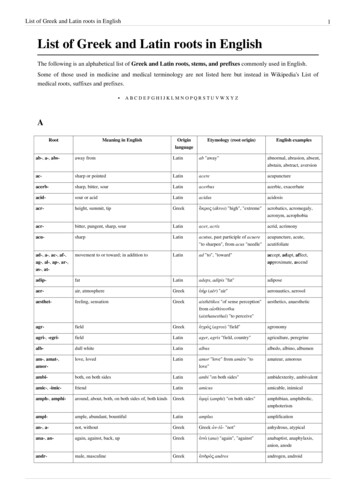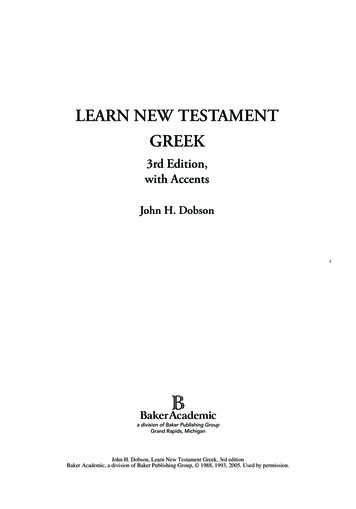
Transcription
LEARN NEW TESTAMENTGREEK3rd Edition,with AccentsJohn H. DobsonAn audio CD-ROM accompanies this book. KJohn H. Dobson, Learn New Testament Greek, 3rd editionBaker Academic, a division of Baker Publishing Group, 1988, 1993, 2005. Used by permission.Dobson LNTGreekCopyright.indd 3LNTG.indb 34/28/14 3:14 PM29/3/07 11:13:54 AM
1988, 1993, 2005 by John H. DobsonThis 3rd revised edition (updated) and audio CD-ROM copyright 2005 by Piquant Editions LtdPO Box 83, Carlisle, CA3 9GR, United Kingdomwww.piquanteditions.comPreviously published in 1988, 1992 by the Bible Society (UK)This edition co-published in North America in 1989, 1993, 2005 by Baker Academic,a division of Baker Publishing GroupP.O. Box 6287, Grand Rapids, MI 49516-6287www.bakeracademic.comPaperback edition published 2014ISBN 978-0-8010-1726-1Printed in the United States of AmericaAll rights reserved. No part of this publication may be reproduced, stored in a retrieval system, or transmitted in any form or by any means—for example, electronic or mechanical, including photocopying orrecording—without the prior written permission of the publisher. The only exception is brief quotationsin printed reviews.British Library Cataloguing-in-Publication DataDobson, John H.Learn New Testament Greek. – 3rd rev. ed.1. Bible. N.T. – Language, style 2. Greek language, Biblical – Grammar I.Title487.4ISBN 10: 1-903689-28-7ISBN 978-1-903689-28-8Library of Congress Cataloging-in-Publication Data for the hardcover edition is on file at the Libraryof Congress, Washington, DC.ISBN 10: 0-8010-3106-0ISBN 978-0-8010-3106-9Quotations from the Greek New Testament are from the United Bible Societies’ 4th revised edition, publishedby the United Bible Societies, copyright The United Bible Societies, 1966, 1968, 1975, 1983, 1993.The Greek fonts used to publish this work are available fromwww.linguistsoftware.com 1-425-775-1130.Cover design by ProjectluzBook design by 2aT (www.2aT.com)14 151617 1819 20 7654321John H. Dobson, Learn New Testament Greek, 3rd editionBaker Academic, a division of Baker Publishing Group, 1988, 1993, 2005. Used by permission.
CONTENTSPreface Introduction 1.2.3.ixxiabg – Learning the Letters ejn ajrch/' – In the beginning ejstivn – is h\n – was 148Introduction to Lessons 4–6 4.5.6.7.8.9.10.11.12.13.14.15.16.17.18.19.12levgw – I am saying, I say levgomen – we are saying, we say lovgo – a word oJ lovgo – the word 131722aujtov – he ou to – this levgwn – saying oJ levgwn – the person saying kardiva – a heart hJ kardiva – the heart hJmei – we uJmei – you o{ – who o} a]n levgh/ – whoever says eja;n levgh/ – if he says i{na levgh/ – so that he may say levgwmen – let us say e[rgon – a work to; e[rgon – the work oJ, hJ, tov – the poievw (poiw ) – I do, I make e[legen – he was saying, he used to say ejpoivei – he was doing, he used to do A to W – Alpha to Omega prov , eij , ejn, ejk, ajpov e[rcetai – he comes, he goes levgein – to say, to be saying levgwn, levgousa, levgon – saying 2734414956637178859197101104Introduction to Lessons 20–25 20.21.111poivhsa – having done ejpoivhsa – I did, I made e[graya – I wrote, I did writev113 120John H. Dobson, Learn New Testament Greek, 3rd editionBaker Academic, a division of Baker Publishing Group, 1988, 1993, 2005. Used by permission.
22.23.24.25.26.27.28.29.30.31.32.33.34.balwvn – having thrown ejlqwvn – having gone e[balon – I threw h\ra – I picked up ejsqivw – I am eating e[fagon – I ate levgein — to be saying eijpei n — to say katabaivnonto aujtou – while he was coming downkatabavnto aujtou – when he had come down ajkouvsw – I will hear balw – I will throw Questions: tiv ; – who? tiv; – what? why? a[nqrwpo ajgaqov – a good man oiJ a{gioi – the saints givnomai – I become, I happen gin genovmeno – having become gen poihvsai – to do ejkbalei n – to throw out baptivzomai – I am being baptized ejbaptizovmhn – I was being baptized ejbaptivsqhn – I was baptized baptisqeiv – having been baptized pepivsteuka – I have trusted, I trust gevgraptai – it has been written, it is written oi\da – I know tivqhmi – I am putting divdwmi – I am giving tiqeiv – putting divdou – giving qeiv – having put douv – having given Introduction to Lessons 35–52 35.36.37.38.39.40.41.42.vikalov – good kalw – well ei , duvo, trei – one, two, three i{na – so that, that i{na poihvsh/ – so that he may do i{na dw men – so that we may give oJ Kuvrio – the Lord to;n lovgon, th;n kardivan: the accusative case w{ste – with the result that tou lovgou, th kardiva : the genitive case tou to poivhson – do this! mh; klevyh/ — do not steal mh; klai e – do not weep, stop crying tw'/ lovgw/, th/ kardiva/: the dative case Learn New Testament 217224234240249255260John H. Dobson, Learn New Testament Greek, 3rd editionBaker Academic, a division of Baker Publishing Group, 1988, 1993, 2005. Used by permission.
43.eij ejmerivsqh – if it has been divided eja;n merisqh/ – if it should be divided 269Introduction to Lesson 44 44.45.274divkaio – righteous dikaiosuvnh – righteousness ajdikiva – injustice, wrong nivptw – I wash (someone or something else) nivptomai – I wash (part of myself) 46. Translating – Romans 1:1–7 47.50.ei\pe o{ti ejsqivei – you said that he was eating gevnoito – let it happen, may it happen dedwvkei – he had given i{na hJ cara; uJmw n h/\ peplhrwmevnh293297307ACKP 51. Culture and Translation 52.28428848. The Influence of Hebrew and Aramaic 49.275314321[Agwmen ejnteu qen – Let us go on from here Key to Progress Tests Reference Grammar & Accents Appendix: Some Thoughts on the Teaching of Biblical Languages Scripture Index Index of Grammar & Constructions Index of Greek Words Contents326333335351359365369John H. Dobson, Learn New Testament Greek, 3rd editionBaker Academic, a division of Baker Publishing Group, 1988, 1993, 2005. Used by permission.vii
Symbolscontinuing actionrepeated actioncompleted action time line continued or repeated actionin past time single action, or action withoutspecific reference to continuance completed action or single action inpast timeaction in past time, with a result that continues in present time; e.g. I havewritten. past action, that had a result in past time; e.g. I had iiiGood News BibleSeptuagint (Greek Translation of Hebrew Scriptures)New English BibleNew International VersionNew Jerusalem BibleNew Revised Standard VersionNew Living TranslationRevised English BibleJ B PhillipsLearn New Testament GreekJohn H. Dobson, Learn New Testament Greek, 3rd editionBaker Academic, a division of Baker Publishing Group, 1988, 1993, 2005. Used by permission.
PREFACEThe enormous world-wide sales of the second edition of Learn NewTestament Greek have shown that it is a book that students and tutors aredelighted to use. Translations into Portuguese, Korean, Czech, French andIndonesian, and planned translations into Chinese and Urdu illustrate itsuniversal appeal. So why is a third edition needed?Since I worked on the second edition, I have had 12 years moreexperience of teaching, and my book Learn Biblical Hebrew has beenpublished. In this third edition I have included teaching material that I findbrings insight and delight to those who learn. My growing knowledge ofHebrew has enabled me to appreciate the literary skill of the NT writers ina new way. I have also discovered that often a word or passage in the NewTestament that is perplexing becomes clear when it is translated back intoHebrew. In this third edition I have tried to share some of the new things Iam learning.I have also found that in the UK and the USA people are pleased to havehelp in comparing and assessing Bible translations. So I have included someBible translation assessment exercises. These exercises will at the same timeassist tutors using the book for distance learning. They will be able to testprogress not only by setting NT texts for translation but also by asking forcomments on the variety of translations of a particular passage offered inthe exercises.The greatest delight of my own students comes from reading andunderstanding biblical passages. I have increased the amount of readingmaterial – especially the amount from the Gospel of St John.The tape which was available with the first and second editions coveredonly lessons 2–14. Now with an audio CD-ROM we can include materialfrom lessons 1–21.Many tutors have asked that the text should be clearer to read and beaccented. This edition has an accented text and is easier to read. In theappendix there is a short section with guidelines and suggestions for thosewho teach. I am always glad to answer questions about teaching methodsand to listen to suggestions for improving the book. Please let me know ifyou find any errors.ixJohn H. Dobson, Learn New Testament Greek, 3rd editionBaker Academic, a division of Baker Publishing Group, 1988, 1993, 2005. Used by permission.
To those of you who want to understand better the Hebraic backgroundto the New Testament I commend the companion volume Learn BiblicalHebrew – see page 385 for more information.Enjoy your learning and teaching,John H DobsonPublisher’s note: Previous printings of Learn New Testament Greek includeda CD-ROM containing audio files to enhance the learning experience. Thispaperback edition no longer includes a CD-ROM. The audio files are now available online at http://bakeracademic.com/LearnGreek/esources. Referencesto the CD remain in the book. Readers are advised to substitute “website”whenever they see “audio CD-ROM” in the book.xLEARN NEW TESTAMENT GREEKJohn H. Dobson, Learn New Testament Greek, 3rd editionBaker Academic, a division of Baker Publishing Group, 1988, 1993, 2005. Used by permission.LNTG.indb 10Dobson LNTGreekCopyright.indd 629/3/07 11:13:56 AM4/28/14 4:04 PMLNTG.indb
INTRODUCTIONThe New Testament is a remarkable collection of writings. No book has hada more profound influence on the world’s history.If you wish to study the New Testament, it helps greatly if you are ableto read it in the original language. With this course it is possible to LearnNew Testament Greek quickly, even if you have never attempted to learn alanguage before. In the first hour you will begin to read and reflect on someNew Testament text. After seventeen short lessons you will begin to readlonger passages. By the end of the course you will have been helped to readabout fifty passages from the New Testament. You will also have a graspof the structure of the Greek language and its grammar, an ability to usecommentaries that refer to the Greek text, and a growing skill as a translator.Because a lot of Greek will be fixed in your long-term memory you will beable to read much of the New Testament without constant reference to adictionary.The principles and methods used in Learn New Testament Greek ensurethat you will make rapid progress with your studies. New information isintroduced in small bits, which makes it easy to take in. It is frequentlyrepeated, which makes it easy to remember. You learn words and formsbefore grammatical descriptions, which is the natural sequence – a childlearns ‘mouse’ and ‘mice’ before it learns that ‘mouse’ is a noun and that‘mice’ is plural. But because you can work through the course quickly, youcan also learn the main grammatical forms and terms quickly, and you willlearn how to parse Greek words.In Learn New Testament Greek you will not be asked to memorize longlists of words or grammatical forms. You will rather learn the principles andpointers which enable you to recognize the meaning and function of wordswhich are new to you. This will equip you to tackle even unfamiliar passagesof the New Testament with confidence.Learning New Testament GreekYou can use these lessons for study on your own or with a teacher. Most ofthe Greek sentences and passages are printed with an English translationon the right-hand side of the page. This means that you can start withoutxiJohn H. Dobson, Learn New Testament Greek, 3rd editionBaker Academic, a division of Baker Publishing Group, 1988, 1993, 2005. Used by permission.
any fear of making serious mistakes. We now know that looking at shortsentences and phrases in a new language with a translation beside them isan excellent way to start learning a language. You are not cheating whenyou look at the translation, you are helping yourself learn. And, when youread the Greek with the translation covered, you can uncover it stage bystage to check whether you have understood it.If you have a CD-player you will find the Learn New Testament Greekaudio CD a useful aid. You can hear Greek sentences and passages from thefirst 21 lessons read aloud. Follow the text as you listen: your ears and eyeswill work together to fix ideas in your mind.Use the audio CD to get a general idea of the lessons you are going tostudy. Use it to review lessons you have done.Instructions and suggestions1. When you begin a new lesson, first read through it quickly, looking atthe English and the Greek. Then work through it carefully, reading andtranslating the passages given.2. The ‘Translate’ section has a line down the middle. Cover the right-handcolumn, using a plain piece of card or paper.3. When you have read a line or a group of lines in Greek, move your pieceof card a little way down the page and check that you have understoodwhat the Greek means. If you made a mistake, mark that line and learnfrom it.If you do not know and cannot guess the meaning of a word, do notspend a long time looking at it. Use the check-column to find out whatit means. Underline it or highlight it.4. If you find that something in a lesson is not quite clear:(a) See if the English translation can help you to understand it(b) Continue to the end of the lesson(c) Do the next two or three lessons, because what you start to learn inany lesson is confirmed in the lessons that follow(d) Review earlier lessons in case there is something you have missed(e) Do not feel that you need to learn things the first time you see them.When you learned your own language you did not learn the wordfor ‘Mummy’ the first time you heard it. In Greek when you first seexiiLearn New Testament GreekJohn H. Dobson, Learn New Testament Greek, 3rd editionBaker Academic, a division of Baker Publishing Group, 1988, 1993, 2005. Used by permission.
ejgevneto – ‘it came into being’, be content with that. You will learnrelated forms later on and they will be easier because you have seenejgevneto.5. Work at your own speed, but go as fast as you can. At the end of eachshort section, pause for a moment of relaxation: take a few deep breaths,stretch your body, stand up, then start the next section refreshed.If you do two lessons a day, six days a week, you will complete the coursein one month. If you do only one lesson a week, you will still finish in ayear. Before you start each new session of study, read through the list ofcontents up to that point. It is a way to review rapidly the major formsyou have learned.6. From lesson 17 onwards you will need a copy of the Greek New Testament(see lesson 52.3 for more details).7. If you are learning Greek because you wish to read the New Testament,you need not worry about how you pronounce it. The Greek languagehas changed as time has passed, and there is no single way that can becalled the ‘right’ way to pronounce Greek words. Lessons 1 and 2 giveguidelines, but they are not rules. Listen carefully to the audio CD. If yourteacher has a different way of pronouncing Greek, listen carefully to yourteacher.8. Words are best learned by being seen in meaningful contexts. Words areflexible symbols. Their meanings vary according to the context in whichthey are used. So read and re-read the text of the lesson, but above allre-read the New Testament verses and passages.9. Grammatical terms: when you go through the course for the first time,do not spend time and effort trying to learn them. To do so might hinderyour efforts to learn Greek. Leave them for more careful study when youhave read more of the New Testament. They will make more sense whenyou review them later on.10. In these lessons everything that needs to be learned is written on thepages. So as soon as you have understood a lesson, you can use it tohelp others to learn; since all you have to do is to lead them through thepages and to help them to smile. Smiles stimulate study!11. Enjoy your studies and take pleasure in your progress.IntroductionJohn H. Dobson, Learn New Testament Greek, 3rd editionBaker Academic, a division of Baker Publishing Group, 1988, 1993, 2005. Used by permission.xiii
John H. Dobson, Learn New Testament Greek, 3rd editionBaker Academic, a division of Baker Publishing Group, 1988, 1993, 2005. Used by permission.
Lesson 1abg – Learning the Letters1.1 The Greek alphabetThe first step in learning New Testament Greek is to recognize the letters ofthe Greek alphabet. Several are similar to English letters, although this cansometimes be misleading (r looks like ‘p’ but sounds like ‘r’).In the first column below, you will find the Greek letters with their closestEnglish equivalents. The second column has groups of Greek letters and tellsyou how they are pronounced. When you have studied these carefully, tryto read the groups of letters in the third column. Cover the fourth columnwhile you read, then use it to check that you have recognized the letterscorrectly.Greek lettersRead thegroups oflettersGreek groups oflettersEnglishequivalentsab – abgab – gabbad – badbed – bedbez – bedzba abbabagdab gadbeg dedbez beddaz zedba abbabagdab gad dadbeg ded abedbedz bed gadzdadz dzed bada–ab–bg–gd–de–ez – dz or ds, as in‘cords’h – ē (‘ai’, as in gh – gē‘air’, or ‘ay’, as in‘say’)q – thdeq – dethi–ibid – bidk–kl–lkiq – kithlid – lidm–mmh – m dadabedgazbadbh dh hd hzhdedadedbē dē ēd ēdzbaq gaq beqbig biz didhdidkid kiz khklad leg bellbeqelmaq mhk kamelbath gath bethbig bids did did1ē kid kidz k klad leg bellbethelmath m k camelJohn H. Dobson, Learn New Testament Greek, 3rd editionBaker Academic, a division of Baker Publishing Group, 1988, 1993, 2005. Used by permission.
n–nman – manx–xax – axo–oox – oxp–ppop – popr–rran – rans , –ssip – sip( is used only atthe end of words)t–tset – setbuk – bookFrench ‘lune’, or‘oo’ as in ‘book’;‘w’ when it startsa wordf – ph, ffut – footu – ‘u’ as inc – khcaki – khakiy – psliy – lipsw–ō fwn – ph n‘o’, as in ‘phone’J–haJt – hat(Written over aninitial vowel)jajt – at(Written overinitial vowelwhen there is no ‘h’ sound)2men nhm qinkinex mix nix niklax laz bixbiznod nag moqonpip pox pozphdrip rig phmarksap skillgospel rib nag sag sat sit thk totluk kuktuk rukuiq uinmen n m thinkinex mix nix niklax ladz bixbidznod nag mothonpip pox podzp drip rig p marksap skillgospel ribsnags sagssat sitst k totlook kooktook rookwith winfit fatfist foxcristo cristofertiy taytap riyfwtw swp sopfit fatfist foxkhristoskhristophertips tapstap ripsiJt aJmoJt wJp iJyhit hamhot h p hipsajm ijt ojn hjtijll iJll oJyam it on till hill hopsLearn New Testament Greekphōtō sōp sopJohn H. Dobson, Learn New Testament Greek, 3rd editionBaker Academic, a division of Baker Publishing Group, 1988, 1993, 2005. Used by permission.
1.2 Greek you already knowAs you begin to read Greek, you will find that you can already understandsome words, because there are English words like them. Notice, forexample:profhvth – prophetCristov – Christajpovstolo – apostleqrovno – throneOther words you will quickly recognize because English words are derivedfrom them:qeov – Godlovgo – worda[nqrwpo – manajrchv – beginninggravfw – I writeejn – infw – lighttheologytheology, logicanthropologyarchaeologygraph, paragraphentryphosphorus.You may also know:Kuvrie ejlevhson Lord have mercyWhen you learn Kuvrio – Lord, master, owner; you will be aware that inspeaking to someone, you say Kuvrie.You may know ‘Jesu, joy of man’s desiring’; so when you learn jIhsou – Jesus, this will help you to be aware that someone speaking to jIhsou will say jIhsou .If you know the tune of Kumbaya (‘Come by here’) you may like to usee[rcou ‘Come!’ and w de ‘here’ to sing:[Ercou w de Kuvrie (3 times)w\ jIhsou Kuvrie.1.3 Writing the lettersThe arrows show you the easiest place to begin when writing a Greekletter.Notes:1. Do not put a dot over i .2. Be careful to make n pointed: n , and u round: u .Lesson 1John H. Dobson, Learn New Testament Greek, 3rd editionBaker Academic, a division of Baker Publishing Group, 1988, 1993, 2005. Used by permission.3
Lesson 2ejn ajrch/ – In the beginning2.1 The Greek alphabet – small lettersLook again at the alphabet:a–ah– n–nt–tb–bq – thx–xu – oo, wg–gi–io–of – phd–dk–kp–pc – khe–el–lr–ry – psz – dzm–ms, – sw– 2.2When two vowels come together, they give the following sounds:ai – i, aiei – eioi – oiau – au, oueu – eu, yewou – ooui – ui, wiih – y (as in mile, aisle)(as in veil)(as in boil)(as in out)(as in feud)(as in root)(as in we)(as in Yale)So aiJ is pronounced like ‘high’, euj is pronounced like ‘you’, andjIhsou is pronounced ‘Y -soos’.Note that when two vowels make a single sound at the beginning of aword, the breathing mark j or J is written over the second vowel.2.3When g occurs before k,‘g’.gg – ngc, or another g, it is pronounced as ‘n’ rather thangk – nkgc – nkhSo a[ggelo is pronounced rather like ‘angle-os’.4John H. Dobson, Learn New Testament Greek, 3rd editionBaker Academic, a division of Baker Publishing Group, 1988, 1993, 2005. Used by permission.
2.4Read the following lines carefully. Start by reading the Greek words while youkeep an eye on the English equivalent. Then cover the right-hand columnand read the Greek words again. Uncover the right-hand column to checkthat you are correct. See that you know the sound the letters make. You willlearn the meaning of the words in 2.5.Cover this columnejn ajrch/ h\n oJ lovgo kai; oJ lovgo h\n pro; to;n qeovnkai; qeo; h\n oJ lovgo .ou to h\n ejn ajrch/ pro; to;n qeovn.en arkh n ho logoskai ho logos n pros ton theonkai theos n ho logos. Note that i can be written underneath a, h and w: a/ h/ w/. It is notpronounced, or is pronounced very lightly. You see it in this lesson in theword ajrch/ .2.5 Wordsajrchv – beginningh\n – he was, it waskaiv – andlovgo – wordejn – inoJ – theqeov – Godprov – towards, withtovn – theou to – this, he2.6 Read and then translateCover up the right-hand column and translate the passage, uncovering theright-hand column to check each line. Do not read the notes below untilyou have translated the whole passage.ejn ajrch/ h\n oJ lovgo ,kai; oJ lovgo h\npro; to;n qeovnkai; qeo; h\n oJ lovgo .ou to h\n ejn ajrch/ pro; to;n qeovn.In (the) beginning1was the word,and the word waswith (the) God2and the word was God.3He was in the beginningwith God.Lesson 2John H. Dobson, Learn New Testament Greek, 3rd editionBaker Academic, a division of Baker Publishing Group, 1988, 1993, 2005. Used by permission.5
Notes:1. ejn ajrch/ – in beginning. ‘In beginning’ is not good English. We translateas ‘In the beginning’.2. pro; to;n qeovn – with the God. In English we do not usually use ‘the’when referring to God, so we translate as ‘with God’.3. kai; qeo; h\n oJ lovgo – and the word was God. Notice that the order ofwords is different in English.2.7 TranslationYou have read and translated John 1.1. You have noticed that ideas in Greekand in English may be expressed in different words. To translate is not to putthe words of one language into another: it is to express the meaning of thewords in another language.2.8 The beautiful Hebraic poetic patterning of John 1:1–2Hebrew poets made use of carefully crafted word patterns and repetition ofkey words. Sometimes they combined two patterns together. In John 1:1–2we find terrace patterning and chiasmus. In terrace patterns the last word ofone line is used as the first main word of the next line. Many commentatorshave noticed this in John 1:1 Note lovgo . lovgo and qeovn. qeo; :jEn ajrch/ h\n oJ lovgo kai; oJ lovgo h\n pro; to;n qeovnkai; qeo; h\n oJ lovgo But the dominant pattern in 1:1–2 is chiasmus. In a chiasmus there is a stepby step forward movement to a central focus and then a balancing step bystep backwards to the closure. This produces patterns like ABC C’B’A andABCDC’B’A’.AjEn ajrch/ Bh\nCoJ lovgo kai; oJ lovgo Dh\nE pro; to;n qeovnkai; qeo; D’h\nC’oJ lovgo ou to B’h\nA’ ejn ajrch/ pro; to;n qeovn A’ closure: A, plus part of thecentral focus6Learn New Testament GreekJohn H. Dobson, Learn New Testament Greek, 3rd editionBaker Academic, a division of Baker Publishing Group, 1988, 1993, 2005. Used by permission.
Note that in an extended chiasmus the most emphatic point is at thecentre. This is a feature to be found in some of the parables of Jesus. Here inJohn 1:1–2 the major emphasis is on the word qeov .The closure echoes the beginning but is extended by including part ofthe central focus. This kind of extension in a closure is also a feature ofHebrew poetry.Note also the threefold use of the key words lovgo and qeov .John1:3–10 is also a chiasmus, and we shall see a key word repeated threetimes in verse 3, and a key word three times in verse 10. Verse 10 repeatspart of verse 3, helping to mark the closure.Lesson 2John H. Dobson, Learn New Testament Greek, 3rd editionBaker Academic, a division of Baker Publishing Group, 1988, 1993, 2005. Used by permission.7
Lesson 3ejstivn – ish\n – was3.1ejstivn means ‘he is’, ‘she is’, or ‘it is’.h\n means ‘he was’, ‘she was’, or ‘it was’.When we translate ejstivn and h\n we can only tell whether to use ‘he’, ‘she’,or ‘it’, by reading the passage as a whole.Compare(a) jIhsou h\n pro; to;n qeovn. ajlhqh; Jesus was with God. He was true.(b) Mariva h\n pro; to;n qeovn. ajlhqh; Mary was with God. She was true.(c) oJ lovgo ajlhqh; h\n kai; ajlhqhv The word was true and it is true.h\n.h\n.ejstinNote that the word order is often not the same in English as it is in Greek. Forajlhqh; h\n in (a) we do not say ‘True he was’, but ‘He was true’. Compareqeo; h\n oJ lovgo in 2.6. In this sentence oJ (the) indicates that the subjectis lovgo , so we translate it, ‘The word was God’.3.2 TranslatejIhsou ejstivn.jIhsou h\n.oJ lovgo h\n.oJ lovgo ejstivn.qeov ejstin oJ lovgo .ajlhqhv ejstin oJ lovgo kai; ajlhqh; h\n.7. ejn ajrch/ h\n oJ lovgo ,kai ejn ajrch/ ajlhqh; h\n.1.2.3.4.5.6.Jesus is.Jesus was.The word was.The word is.The word is God.The word is trueand it was true.In the beginning the word was,and in the beginning it was true.8John H. Dobson, Learn New Testament Greek, 3rd editionBaker Academic, a division of Baker Publishing Group, 1988, 1993, 2005. Used by permission.
3.3 WordsoJ lovgo – the wordou to oJ lovgo – this wordoiJ lovgoi – the wordsejstivn – he is, she is, it isoJ Ma rko – Markeijsivn – they areoJ jIhsou – Jesush\n – he was, she was, it wastou – of theh\san – they weretou jIhsou – of Jesusgravfei – he writes, she writesou to – this, hegravfei to;n lovgon – he writes the wordou toi– thesegravfei tou; lovgou – he writes the wordsajlhqhv – true, genuine, real, honestou toi oiJ lovgoi ajlhqei h\san – these words were true3.4 Translate1. oJ lovgo ajlhqhv ejstin.The word is true.2. oiJ lovgoi ajlhqeiv eijsin.The words are true.3. ou to oJ lovgo ajlhqhv ejstin.This word is true.4. ou toi oiJ lovgoi ajlhqei eijsin.These words are true.5. ajlhqh; h\n oJ lovgo .The word was true.6. ajlhqh; h\n oJ lovgo tou jIhsou .The word of Jesus was true.7. gravfei to;n lovgon.He writes the word.8. gravfei tou; lovgou .He writes the words.Mark writes the words.He writes the words of Jesus.gravfei tou; lovgou tou jIhsou .ou toi oiJ lovgoi tou jIhsou ajlhqei These words of Jesus are true.9. oJ Ma rko gravfei tou; lovgou .eijsin.10. oJ jIhsou h\n pro; to;n qeovn. ou to h\n ejn ajrch/ pro; to;n qeovn.11. ou toi eijsin oiJ lovgoi tou jIhsou kai; oiJ lovgoi tou Mavrkou.Jesus was with God. He was inthe beginning with God.These are the words of Jesusand the words of Mark.3.5You have begun to learn the following Greek words. Notice the English wordsthat are like them. Many English words are derived from Greek words.Lesson 3John H. Dobson, Learn New Testament Greek, 3rd editionBaker Academic, a division of Baker Publishing Group, 1988, 1993, 2005. Used by permission.9
Greek wordhJ ajrchv – the beginningoJ qeov – God, the GodoJ lovgo – the wordjIhsou – JesusMa rko – Markejn – inejstivn – he is, she is, it iseijsivn – they aregravfei – he writes, she writesprov – to, withComparearchetype – original modelarchaeology – study of things fromearlier timestheism – belief in Godtheology – study of Godlogic, theology, archaeologyJesusMarkenter, inisisgraph, paragraph, graffitiprosthetic3.6(a) Using the patternsoiJ lovgoi tou jIhsou – the words of JesushJ ajgavph tou qeou – the love of Godand the words from 3.5say in Greek:The words of Jesus – the words of God – the word of God –the word of Mark – the words of Mark – the love of God –the love of Jesus – the beginning of the word.(b) Using the patternsajgaqov ejstin oJ qeov – God is goodajlhqh; h\n oJ lovgo – the word was truesay in Greek:God is good – the word is good – Mark is good – the word is true –the word was true – Mark was honest – the word was good.(c) Learn by heart from 1 Jn 1:5 oJ qeo; fw ejstin (God is light)and from 1 Jn 4:16 oJ qeo; ajgavph ejstivn (God is love).10Learn New Testament GreekJohn H. Dobson, Learn New Testament Greek, 3rd editionBaker Academic, a division of Baker Publishing Group, 1988, 1993, 2005. Used by permission.
3.7 Progress test 1
NEB New English Bible . NJB New Jerusalem Bible NRSV New Revised Standard Version NLT New Living Translation REB Revised English Bible JBP J B Phillips John H. Dobson, Learn New Testament Greek, 3rd edition . Baker Academic, USA toll free

